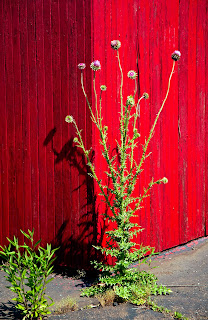On, 2003
What if?
We ask ourselves that question many times. What if I had followed a different path, gone to a different school, made different friends, moved to a different city, married a different person? There are no answers to these questions, only opportunities to dream of what might have been.
Just a few months short of my fortieth birthday I found myself unemployed for the first time since high school. I'd had part-time jobs from the time I was fifteen to make spending money for dating, books, clothes and school supplies. After college one job lead seamlessly into the next as I moved up in the companies where I'd assumed I'd make my career.
Then it all came to a standstill. The ad agency I worked for was sold. The new owners asked me to stay. But the place that had once been a Camelot became instead whatever the opposite of Camelot is. At the end of my first year with the new owners, I became the latest victim of a "reduction in force."
To make matters worse, this took place two weeks before Christmas, not exactly a time you want to bring bad news home or bring your friends down by talking to them about other opportunities. As luck would have it, though, word got around and good job offers appeared. I appreciated those gestures, but decided not to pursue them and, instead, opened my own business. In January, that business will celebrate its twentieth birthday.
The best gift that holiday, it turns out, was the realization that I'd been compelled to revisit my life, to be free of a dreadful workplace, to shed habits that weren’t good and fill more of my life with others that were. I could revise what I did for a living. I could have more time for the things that provided satisfaction. It was in fact so empowering that I started telling my friends that if they were lucky they, too, would get “riffed” and have a similar opportunity for personal reinvention.
All this came to mind when I read a story in yesterday's New York Times about artist Lonni Sue Johnson, who at age fifty-seven experienced severe brain damage. Ms. Johnson had to re-learn how to walk, talk, read and take care of herself. She had to remember or re-learn who the people were in her life. She had to learn who she was. As much as anyone can, she had a clean slate.
I gather that the traditional approach in such cases is to help the patient get back to, or at least remember how he or she used to be, by doing things that unlock the memories and personality traits packed away behind the tissues of the diseased brain. Johnson's mother helped her rediscover her artistic interest, first by having her copy simple lines and shapes and later by drawing a straight line or curve on a page and letting Ms. Johnson use that line as the starting point for completing a larger scene.
Lonni Sue Johnson has made amazing progress. Not everyone who suffers brain injuries is so lucky. Her experience, though, coupled with my own “clean slate” experience—feeble thought it may be in comparison—got me wondering whether I’d want to go back to having the same artistic interests if faced with the same clean slate or instead take off in a new direction if faced with the same situation.
How about you? Would you pursue different forms of artistic expression? Switch from art to music or from music to writing or from writing to performance art?
Again, it's hard to know what the answers would be. There’s probably a lot of comfort in rediscovering familiar old neural pathways. Yet this experience could theoretically be the gateway through which the old mind enables new consciousness and insights.
Hopefully none of us will have to face this decision. Maybe we’d all rush back to find our old selves just as fast as we could. But if we didn’t isn’t it interesting to wonder how we could use that clean slate?

































